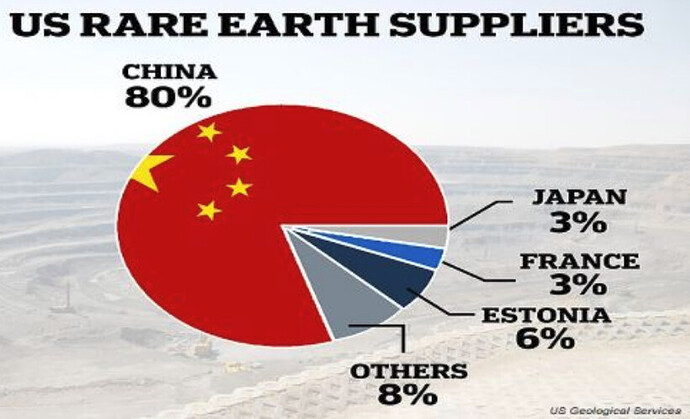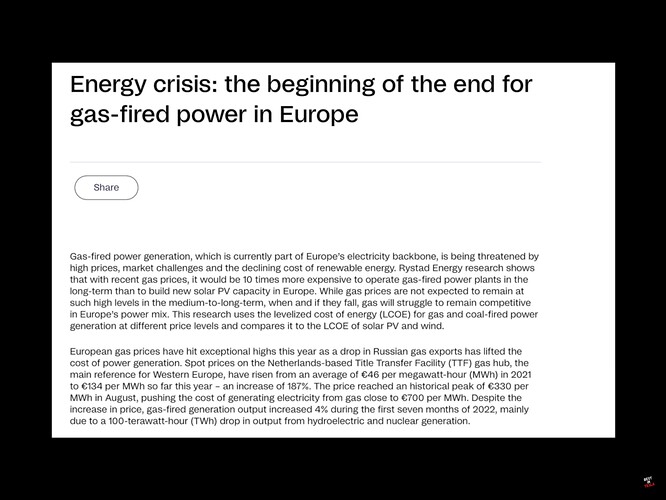40kw battery less 50% capacity is 20kw
for R60k it would be a good deal for a home use battery bank.
Do Lithium batteries behave the same as lead-acid?
They have the capacity for many more cycles but does the 50% SOC apply in the same manner as for LA?
In some ways they do. Usually I use this example. When you design the system, you decide the minimum capacity that is required to do the job. Then you spec a battery that is larger than the minimum capacity, so that there is room for degradation. The battery starts to wear from day one. When it gets to the point where it can no longer do the job, it is considered EOL.
For example, say you pick the 50% number. Let’s say you need 10kWh of storage each day, so you spec a battery bank that is 20kWh in size, and you discharge it to 50% DoD each day. The battery degrades gradually and after roughly 1200 cycles (pretty typical of a golf cart battery) you hit the 50% point… the power goes out before the sun rises again tomorrow.
When it comes to the starter battery in a car, it is EOL the first morning it cannot start the car. At that point it has less than 2% of the original capacity left.
So this is the first part to understand when it comes to battery life. The engineer who designs the system decides what the EOL percentage will be. Pick a higher EOL percentage, and you will have less cycles before you get there. It is as simple as that.
Then marketing gets involved. They want a higher cycle number. But the cycle life is always in inverse proportion to the EOL percentage.
For electrical cars, the typical EOL number is between 70% and 80%. That is the point when the car can only go 80% as far as it could before.
But the important part here is that the designer picks the numbers. He decides how much capacity he needs to install so that he can get X cycles out of the thing.
Now for Lithium. They do way more than 1200 cycles down to 50%. They do twice that to 0%. That means an engineer doesn’t have to fit twice the capacity in order to get a marketable number. But that also means they have a higher EOL percentage, which means “perfectly good” lithium batteries come out of electric cars and can move on to other applications.
And that is again not too different from lead acid. Once a golf cart can no longer make it to the 18th hole, they are EOL in that application, but the batteries may well be good enough for another 6 months in a small solar system.
The only thing with lead acid, where it really loses the competition, is that they tend to develop a catastrophic failure in one cell, and then they take the whole bank with them.
At this point I probably need to put my cellphone comment into context. I said after 4 years they still show no battery issues. But I generally don’t go below 45% SoC, maybe 42% on a bad day. That’s just how my habits pan out. That means that the EOL percentage for me, the day I need to urgently replace the phone because it no longer does the job, is the day the battery has degraded more than 60%. And that, empirically determined, takes more than 4 years. But in a manner of speaking, I picked the numbers that gave me that result, even if not consciously. My phone has a 5000mAh battery. If it had a 3500mAh battery, I’d be singing a different tune.
Wonder now no more……
Groetnis
Well, is that part of a trend, or anecdotal evidence?
Because the same Stellantis is making an electrical Jeep now (The Avenger, smaller than the current entry level Renegade).
That is true, but they are not the leading lithium producer. Lithium is technically also not a rare-earth metal. Cobalt however is…
The leading producer of Lithium is Australia. Chile has the largest reserves. China is nr. 3. There is no real reason China has to call the shots for the US. They do because the US allows them to.
USA does not want to do the dirty work of making batteries, hence China said “give it to us, we can do it cheaper” … and there they sit.
Factories and all the regulations, the remuneration of the staff, gets very expensive very fast. Now after Covid, the Western powers have learned what it means when you close down factories because some feel it is not “healthy”.
Reminds me of one called Fluffy on 4x4: If you fly or drive to an anti-Fracking meeting, you have no business being there and you won’t get my ear …
If you won’t allow factories to build your batteries in your country, then you have no business driving EVs. ![]()
We have to fund this loss making fraud scheme… It will likely be shut down early, in spite of DeRuyter’s protestations. Even Less energy for EV’s.
Groetnis
Soon, there will be no other financially viable alternatives to the combined Solar PV, Wind and Battery storage systems. They would need 2 - 4 days worth of storage capacity and about 4 times peak Power panels and wind turbines to feed this.
Groetnis
This debate seems to have been forgotten: https://www.4x4community.co.za/forum/showthread.php/360285-Electric-Cars-vs-Biofuels
PS: Is the Blue Team the same one as on this forum?
That list misstates so many things or gets them completely wrong… I don’t even feel like replying to each point individually.
In any case, no drawbacks of existing vehicles are mentioned, not one, so it’s not like they’re really trying to have a balanced conversation.
Not worthwhile that debate over there me thinks. Dunno who team Blue is…
It’s not worthwhile because reasons:
EV’s are inevitable. EV’s are the disruptor just like the original Smartphone was to all voice telecoms and the iPhone still have huge support and a reasonable market share. Dumb phones and analog landlines almost does not exist anymore.
So therefor the rest of those points are irrelevant. The car was an absolute disrupter. It killed the horse drawn buggies in 10 years time. Most horses were also put to pasture. This happened during a World War while the fossil fuels business was build from nothing, including fuelling stations, the road network that did not exist previously and wile there was a Pandemic. So there is that…
Groetnis
I think that EVs’ long distance issue would be addressed in the future with a type of wireless charging on the highways. Paid for by a type of etolling. Even gps tracking and charging data from the car itself. It doesn’t need to provide full charging, just a bit to extend range effectively. I.e. the battery will say do half the work it normally does, doubling the range. Something like that.
Practically I think it is going to be an incredible challenge, and I’m not sure how wireless charging would work at speed, but surely not a problem that engineering can’t solve.
Different Hat… Transport as a Service. Don’t know about local, that may be a challenge however Uber works but who knows.
This is how and why this will work: You may not want to own a car since the price for using a Taxi (EV of course) will be much much cheaper, it may work out to be 10X cheaper than owning a car. So you Taxi toe Bloem or Colesburg on your way to CT, or just drive to Durbs by then. At Colesberg you just get another EV to CT, charge and drive in CT. Then drive back to Colesberg and get another back home.
Groetnis
@TheTerribleTriplet spends some time talking there. I have an account there, because right after we got disgruntled with the Sauronesque government of Mordor, a few of us briefly toyed with the idea of joining that platform, but I have maybe posted 3 times… if that much.
On the one hand that is understandable. The status quo is usually not questioned. The new-comer is. But I absolutely agree with you there, any honest comparison must at least admit that existing vehicles have many of the same problems.
There’s pretty much just these obstacles left, in my mind, more or less in the order I rate them. And as Sarel says, it is inevitable… they will be solved one way or another, or we will live of with the broken pieces of not being able to keep up.
- EVs are prohibitively expensive at the moment. But to be fair, all new cars are prohibitively expensive and make zero financial sense once you factor in devaluation and opportunity costs.
- Recharge time is on the long side, because the chargers we have are not particularly fast (typically 30kW or so). So while range is catching up, your annual holiday trip is about to become a day longer, at least in the short term. This is probably not changing as fast as we would want it to.
- Charging infrastructure. Currently there is very little of it. Yes it will come (built it and they will come?
 ), but when you stop at Laingsburg Engen and there’s a spot for TWO cars only… that can make those recharge queues even longer. On that topic, about a week ago I got there and both the Rubikon Tesla AND another Jaguar were charging at the same time… it’s already happening.
), but when you stop at Laingsburg Engen and there’s a spot for TWO cars only… that can make those recharge queues even longer. On that topic, about a week ago I got there and both the Rubikon Tesla AND another Jaguar were charging at the same time… it’s already happening. - Eskom. This is the FIRST point people on social media mentions, even if I put it at number four. Oh no, this will never work, because load shedding! I usually say to them, people, those cars are going to charge at night, when the demand is low, and for the average distance we travel there really isn’t a problem. Yet. And therein the issue… the “yet” of it. Because in this country, when you ask if there is anything that hasn’t been completely destroyed yet, some people think you’re laying down a challenge. If we do get to a point where Eskom has not only a peak power supply issue, but an overall energy-supply issue, to the extent that it is noticed on a household level, then that becomes a massive deal breaker. Even positive little me, lately, have come to worry a little about this.
Personally I’m happy that ICE is getting regulated away – dragging people kicking and screaming into the future, because the negative externalities that people don’t associate with their new Fortuner or Citi Golf take too long to notice.
However, I’m thinking this whole transition would have been a lot smoother had better vehicles simply been available for similar pricing to ICE. Slower sure, and you have the bootstrapping problem. But it could’ve been nice to simply have better technology without the politics ![]()
(And if it wasn’t better yet, just iterate until it is! But that kind of R&D is extremely expensive.)
I am as well. And also, if we are being completely honest about it, people are being given a really really long advance “warning” on this. It never ceases to amaze me how many Americans I see on social media, bitterly decrying being “forced”, when the deadline is 12 years away. That’s how long the Average American car lasts… which means statistically you can buy a new car now and still drive it into the grave before it becomes mandatory.
Additionally, a careful reading of the European action, shows them having a biannual review and a 2028 target date for any required amendments. Almost as if people actually put some thought into it… you know… between bouts of just wanting to take over the world in the name of lords Gates and Soros.
Again, agreed, but I think the cost of the battery is the problem here. There’s only so much you can do to lower the cost when half the cost is just the battery, and that costs what it costs, right? One thing I said many times, is that an easy way to make the transition smoother would have been to stop focusing on range so much. The best EV range, in the African context, is going to be unconvincing when people think in terms of the annual 1000km holiday trip. Rather focus on giving people a cheap local runabout. You don’t need a big battery for that, and the fuel savings… especially NOW… it must be compelling if you say it right.
Yeah, that’s a big one. I wonder if we might not see more specialised rentals happening, like you go to Avis and get a bakkie for the holidays. Although it’s possible today, I don’t think there’s really enough demand, but as people start switching, there could be a good business model there. (I always do that with trailers now.)
I haven’t seen a good breakdown of the regulations… Do we know if there it’s a blanket ban (not the headline, the actual words) with carveouts, or more of a “consumer passenger vehicle in classes A-F” thing?
You might be forced to do your Africa trip in a Unimog…


